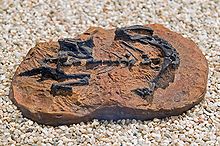| Mussaurus Temporal range: Early Jurassic,
| |
|---|---|

| |
| Fossil juvenile skeleton | |
| Scientific classification | |
| Domain: | Eukaryota |
| Kingdom: | Animalia |
| Phylum: | Chordata |
| Clade: | Dinosauria |
| Clade: | Saurischia |
| Clade: | †Sauropodomorpha |
| Family: | †Mussauridae Bonaparte & Vince, 1979 |
| Genus: | †Mussaurus Bonaparte & Vince, 1979 |
| Type species | |
| †Mussaurus patagonicus Bonaparte & Vince, 1979
| |
Mussaurus (meaning "mouse lizard") is a genus of herbivorous sauropodomorph dinosaur that lived in southern Argentina during the Sinemurian stage of the Early Jurassic. It receives its name from the small size of the skeletons of juvenile and infant individuals, which were once the only known specimens of the genus. However, since Mussaurus is now known from adult specimens, the name is something of a misnomer.
In its early stages of life, Mussaurus was a small quadrupedal herbivore, walking on all four legs. As it grew up, the changes in body proportions may have led its centre of mass to move backwards towards its pelvis. Adults would have been medium-sized bipedal herbivores, measuring up to 8 metres (26 ft) long and weighing up to 1.2–1.6 metric tons (1.3–1.8 short tons).
Numerous specimens of varying age found in a single locality suggest that Mussaurus is one of the earliest dinosaurs to have lived in a gregarious lifestyle. With its possible origin from the Triassic, this complex social behaviour may have given rise to the sauropods' early success as the largest herbivores on land. Mussaurus also possessed anatomical features that suggest a close, possibly transitional evolutionary relationship with true sauropods.